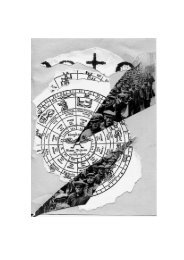P L A N T A R C H Y 2 - Critical Documents
P L A N T A R C H Y 2 - Critical Documents
P L A N T A R C H Y 2 - Critical Documents
You also want an ePaper? Increase the reach of your titles
YUMPU automatically turns print PDFs into web optimized ePapers that Google loves.
44<br />
notions of scoring, and all the elements of the piece become, to use a phrase<br />
from Lyn Hejinian, “maximally excited” (The Rejection of Closure 43). Among<br />
Basinski’s works to be displayed and discussed in this paper are two scores,<br />
SPAR’S EUROPEAN SAUSAGE SHOP, and Madame Kitty Opera [displayed<br />
at the end of this text]. 2 The difference between these two examples is<br />
immediately clear, yet both utilize an openness for a similar purpose of striving<br />
for inexhaustibility in interpretation. Openness in works of art, as I am using<br />
it here, is a concept laid out in Umberto Eco’s Opera Aperta (The Open Work).<br />
The notion was founded on an increasing democratization of art that Eco<br />
found prevalent in the contemporary avant-garde. The open work explored a<br />
“field of possibilities” and “encouraged acts of conscious freedom on the part<br />
of the performer” (Eco 4) that can be seen as a reaction against the status quo<br />
conservation of the classical mode of artistic interaction (traditionally works<br />
of closed nature). In my use of the phrase “open score”, I allude to the ‘open<br />
to interpretation’ element of Eco’s open work, but I suggest a more radical<br />
intervention, more direct invitation, and a focus on the performer rather than<br />
the reader.<br />
Both scoring styles of Michael Basinski exercise a type of openness<br />
that leaves space for interpretation as completion. In both styles, there is a<br />
motivation towards a blank page: the short form pieces give as little as possible<br />
to maintain freedom of interpretation around all undefined borders, while the<br />
visual scores attempt to break down all predetermined conventions, aiming<br />
for the unrestrictiveness of a blank space. Eco’s statement that “A work of art<br />
can be open only insofar as it remains a work” (101), reflects that a blank page<br />
cannot be anything but a blank page without appropriate contextualization.<br />
Like Basinski’s scores, they must always be working toward a blank page, but<br />
never a blank page. For all that exists on the page fully occupied by letters,<br />
animals, invented symbols, and numbers, Basinski’s scores still rely on the<br />
play between all that is there and that which is not. The performer-defined<br />
map that Basinski offers to a performer points to a definition of open works<br />
as purposely partial pieces — the incompleteness opening itself to alternative<br />
readings, multiple performances. Yet if a piece is constructed with too<br />
much openness, it becomes an overwhelming burden for a performer, a<br />
seemingly unwelcoming invitation from the whimsical author, which shifts a<br />
disproportionate creative responsibility onto the addressee. Within this game<br />
of ‘giving just enough’ there is the craft of the open composition: balancing the<br />
generative information within a structure that opens out instead of closing in,<br />
creating a dynamic equation of structure, information and openness, wherein<br />
a piece can either fall silent or become white noise.<br />
Deprived of all indication, all direction, the listener’s ear is no longer





